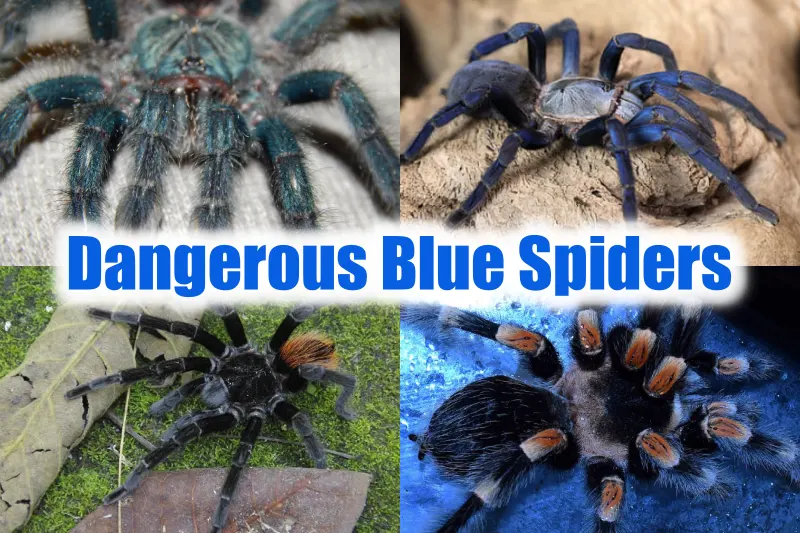Have you ever encountered a blue spider? You must have seen a normal brown spider, but not the blue one. These spiders can be found worldwide, from the deserts of Australia to the rainforests of South America. People believe that the most colorful animal is the most venomous.
Does this statement hold true for these spiders, or is it just a myth? So let’s start the colorful journey of these incredible spiders. Here is the list of 30 Fascinating Blue Spider Species Found in Nature.
Note: (*) means venomous species.
30 Blue Spiders in Nature
1. Metallic blue jumper
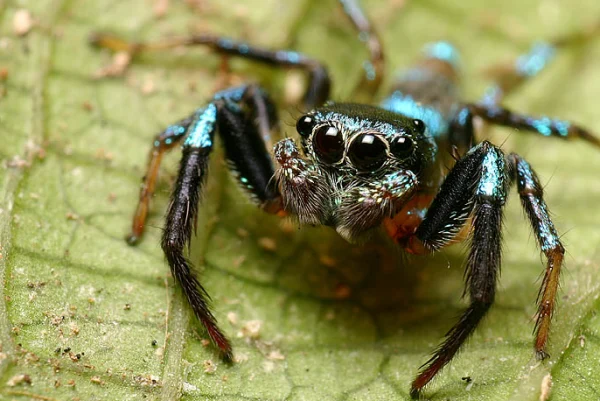
| Scientific name | Thiania bhamoensis |
| Size | No information |
| Diet | fruit flies, mosquitoes, mealworms, and common houseflies |
| Geographical location | Myanmar (Burma), China, India, Krakatoa, Lao, Malacca, Malaysia, Myanmar, Nicobar Islands, Singapore, Sumatra, Vietnam |
Thiania bhamoensis, also known as the metallic blue jumper, is a species of jumping spider found from Burma to Sumatra. This species is known for its iridescent green-blue coloration.
Males are more blue than females; females are more green in color. These spiders are different from other jumping spiders.
They form silken retreats where they molt, rest, and lay their eggs. They are as popular as the fighting spiders because males of these species are known to engage in fights.
2. Socotra Island Blue Baboon Tarantula*

| Scientific name | Monocentropus balfouri |
| Size | 12 cm |
| Diet | small crickets or mealworms |
| Geographical location | Socotra Island |
Another spider on the list of blue spiders is the Socotra Island Blue Baboon Tarantula, endemic to Socotra Island in the Indian Ocean. This spider is known for its beautiful, striking blue appearance.
Their carapace is blue, whereas the abdomen is gray. The legs of these spiders are bright blue, making them distinct. They can grow up to a size of 12 cm.
Communal behavior is also very common in this species, and they usually feed on small crickets or mealworms. They got their name from their discoverer, Isaac Bayley Balfour.
3. Cobalt Blue Tarantula*
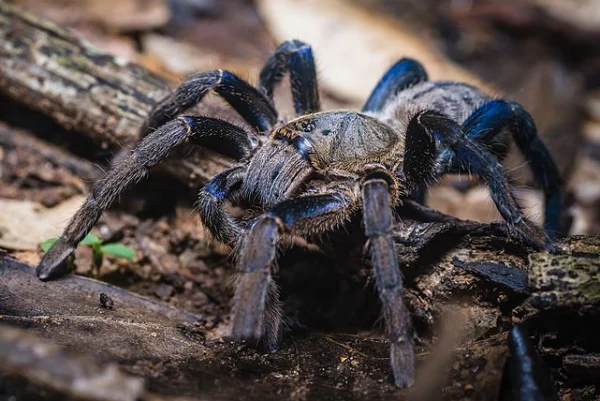
| Scientific name | Cyriopagopus lividus |
| Size | 5 inches |
| Diet | Crickets, dubia roaches, silkworms, king worms, wax worms, mealworms, cockroaches, baby mice, and beetles |
| Geographical location | Burma and Thailand |
This venomous spider is found commonly in Myanmar (Burma) and Thailand. These medium-sized cobalt blue tarantulas can attain a size of up to 5 inches. These spiders are famous for their beautiful blue legs.
After their last molt, they exhibit sexual dimorphism. Males are light tan to bronze in color, whereas females become larger than males and show a blue color.
These species are very popular among insect lovers, though they are venomous. They primarily feed on crickets, dubia roaches, silkworms, kingworms, wax worms, mealworms, cockroaches, baby mice, and beetles.
4. Antilles Pinktoe Tarantula*
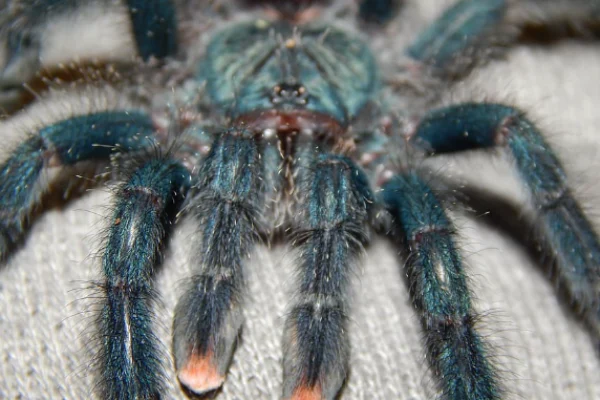
| Scientific name | Caribena versicolor |
| Size | 4.5 to 6 inches |
| Diet | Crickets, locusts, mealworms, and dubia roaches |
| Geographical location | Guadeloupe and Martinique |
Antilles pink toe tarantula, Martinique red tree spider, or Martinique pink toe are some of the common names of Caribena versicolor. These beautiful yet unique spiders are found in Guadeloupe and Martinique, in the Caribbean.
Blue coloration in these spiders is only seen in the juvenile stage, and after each molt, their blue color disappears.
Their carapace turns green, and their abdomen is red and green with red bristles. This spider is very famous as a pet because of its unique coloration and pliant nature.
5. Brazilian blue spider*
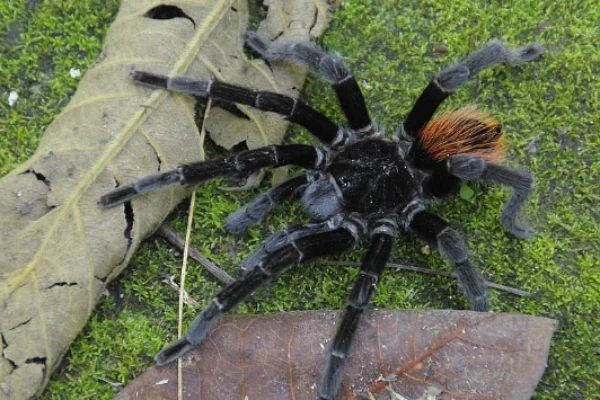
| Scientific name | Pterinopelma sazimai |
| Size | 14-15 cm |
| Diet | Crickets, Fruit flies |
| Geographical location | Bahia and Minas Gerais regions of Eastern Brazil |
Also known as the Brazilian blue spider, it is commonly found in the Bahia and Minas Gerais regions of eastern Brazil. This endangered species is known for its iridescent blue color.
They appear blue when the light strikes them, except for their opisthosoma, which is red in color. These opportunistic borrowers mostly feed on crickets and fruit flies. These are new-world tarantulas and grow up to 14 to 15 cm.
6. Peacock Spider
| Scientific name | Maratus volans |
| Size | 5 mm |
| Diet | Flies, moths, grasshoppers, winged ants (alate), wasps |
| Geographical location | Australia |
The next spider on the list of spiders that are blue is the peacock spider (Maratus volans). These Australian native species occupy a wide variety of habitats.
These spiders are brown but have different color patterns on their bodies, including blue. Cannibalism is also seen in this species, even after mating. Their mating system is quite unique and involves runaway sexual selection.
In these spiders, if the females are not interested in the males, they will attack and eat them. The normal size of these small peacock spiders is 5 mm.
7. Singapore blue spider*
| Scientific name | Omothymus violaceopes |
| Size | up to 9 inches |
| Diet | large beetles, cockroaches, large crickets, mantids, and other large arthropods |
| Geographical location | Malaysia and Singapore |
These beautiful, large Singapore blue spiders attain a size of 9 inches, which is huge in comparison to other spiders. These spiders are commonly found in Malaysia and Singapore.
As their name indicates, they are bright blue in color with a golden carapace. In these old-world tarantulas, females are much more vibrant than males. Like other tarantulas, they are exceptionally fast and highly venomous.
8. Chrysilla volupe
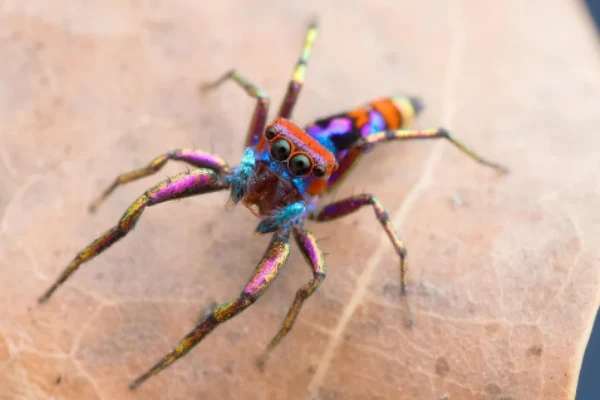
| Scientific name | Chrysilla volupe |
| Size | 5.44 mm |
| Diet | fruit, pollen, and nectar |
| Geographical location | Sri Lanka, India, Nepal, and Bhutan |
Chrysilla volupe is a jumping spider species belonging to the family Salticidae. This spider species is so vibrant and sight-worthy. These spiders are small, measuring 5.44 cm.
The carapaces of these spiders are orangish-red in color with two blue stripes. You can find them jumping and dancing in areas like Sri Lanka, India, Nepal, and Bhutan.
9. Green bottle blue Tarantula*
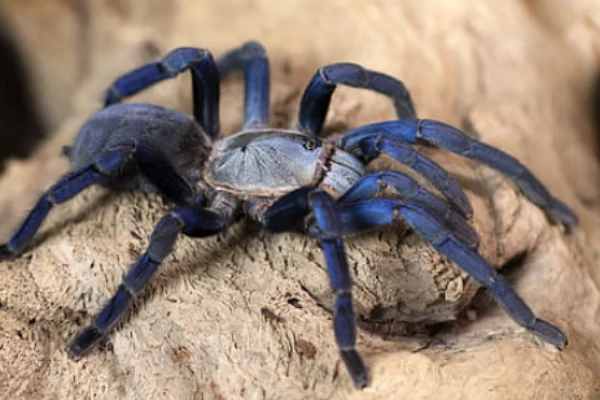
| Scientific name | Chromatopelma cyaneopubescens |
| Size | 2.75 inches |
| Diet | crickets, cockroaches, locusts, beetles, and mealworms |
| Geographical location | Paraguana peninsula in northern Venezuela |
As their name indicates, these green bottle blue tarantulas are known for their blue-green carapace and metallic blue legs. This South American native spider is 2.75 inches in length.
These active and fast-growing tarantulas are famous among pet traders due to their unique appearances. You can find these spiders on the Paraguana Peninsula in northern Venezuela, inhabiting bushes and tree roots.
They mostly feed on crickets, cockroaches, locusts, beetles, and mealworms.
10. Sea green Northern spider
| Scientific name | Cosmophasis thalassina |
| Size | No Information |
| Diet | anemones, worms, jellies, sponges, soft corals, and nudibranchs |
| Geographical location | Southeast Asia and Australia |
Another member of the jumping spider family is the Sea Green Northern Spider. This ex*tic species of spider is known for its unique coloration. They have a beautiful greenish-bronze carapace.
They have distinct white collars that run along each of their dark opisthosomes. Due to their iridescent coloration, they appear blue when light encounters them. You can find this jumping spider in Southeast Asia and Australia, from Malaysia to Sydney.
11. Golden blue-legged baboon Tarantula*
| Scientific name | Harpactira pulchripes |
| Size | 3 to 6 inches |
| Diet | large crickets or mealworms |
| Geographical location | South Africa |
The yellow body and the metallic blue legs make this stunning golden blue-legged baboon unique. They have sexual dimorphism. Males are longer and brighter than females.
This old-world tarantula is very famous among pet traders due to its appealing appearance. They are medium-sized, with an average length of 3 to 6 inches.
The venom of this tarantula species is very useful in the medicine industry. This South African species mostly prefers arid and high-humid areas to live in.
12. Red-headed mouse spider*
| Scientific name | Missulena occatoria |
| Size | 3.5 cm |
| Diet | insects and other spiders |
| Geographical location | Mainland Australia |
Another species of blue-colored spider is the red-headed mouse spider, Missulena occatoria. Their distinctive appearance makes them stand out on the ground.
The male of this species looks quite dangerous, with a redhead and bluish-black abdomen. There is a lot of difference in male and female length. Females can grow up to 35 mm, whereas males are 15 mm.
This Australian native species inhabits a variety of habitats, from open forests to desert shrublands.
These spiders are not just looking dangerous; in reality, they are. Their bites are so toxic that they can even have serious effects on old people and children.
13. Blue foot baboon*
| Scientific name | Idiothele mira |
| Size | 20 to 30 mm |
| Diet | beetles, grasshoppers, millipedes, cockroaches, crickets, and other spiders |
| Geographical location | South Africa |
These species are also known for making trapdoors in their burrows, just like red-headed mouse spiders. Blue foot baboon spider and trap door tarantula are the common names for Idiothele mira.
Due to their distinctive blue tarsals and metatarsals, they are very famous among pet traders in South Africa. They are small, with an average size of 20 to 30 mm.
Females tend to be larger than males. A golden starburst pattern can be seen on the black carapace.
14. Bold jumping spider
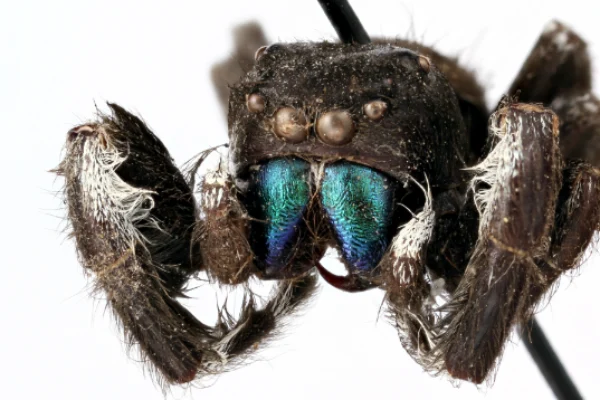
| Scientific name | Phidippus audax |
| Size | 6 to 19 mm |
| Diet | caterpillars, dragonflies, grasshoppers, and other spiders |
| Geographical location | North America |
This North American native Bold Jumper Spider is known for its big eyes and iridescent blue jaws. These carnivorous spider species are found in a variety of habitats, from grasslands to agricultural fields. Females tend to be larger than males.
Females have an average body length of 8 to 15 mm, whereas males have 6 to 13 mm. They are diurnal and mostly feed on caterpillars, dragonflies, grasshoppers, and other spiders.
15. Brazilian Jewel Tarantula*
| Scientific name | Typhochlaena seladonia |
| Size | 3 to 6 cm |
| Diet | small crickets, fruit flies, and some other insects |
| Geographical location | Bahia and Sergipe, Brazil |
This rare Brazilian jewel tarantula, Typhochlaena seladonia, is commonly found in Bahia and Sergipe, Brazil. These rainforest inhabitants got this name due to their unique coloration.
Just like jewels, they occur in many hues, like blue, pink, orange, black, and yellow. They are small in size, measuring from 3 to 6 cm, and can be a good pet for you. These dwarf tarantula have a small abdomen and small legs that make them distinctive.
16. Polychromatic earth spider*
View this post on Instagram
| Scientific name | Haploclastus psychedelicus |
| Size | 13 to 15 cm |
| Diet | Insects |
| Geographical location | Kerala (India) |
Polychromatic earth spiders are species of the Haploclastus genus, and like every other tarantula, they are venomous in nature. It has a striking metallic blue coloration on its carapace and legs.
This species was first described by Sanap and Mirza in 2014. You can find this extraordinary spider in Kerala, India. They appear in two forms: the pink form and the blue form. About their size, they are 13 to 15 cm long.
17. Lace Weaver Spider*
| Scientific name | Amaurobius ferox |
| Size | 5 to 15 mm |
| Diet | Insects |
| Geographical location | Europe, North America, New Zealand |
Amaurobius ferox got its name due to its dark coloration. These nocturnal spiders are small, with an average size of 5 to 15 mm. You can find these dark areas inhabiting species in Europe, North America, and New Zealand.
Matriphagy is also seen in these spiders, which means young ones eat their own mother after hatching. They are shiny and dark, with shades of black, blue, brown, and red. They are known to bite and can cause pain like a wasp sting.
These spiders can cause toxic reactions with a wide range of severity. However, the toxins are typically targeted at their prey and predators.
18. North Queensland jumping spider
| Scientific name | Cosmophasis micarioides |
| Size | 8 mm |
| Diet | insects, such as ants, flies, and beetles, as well as nectar from flowers and extrafloral nectaries |
| Geographical location | Papua New Guinea, Australia, and the Solomon Islands |
The North Queensland Jumping Spider and the Sparkling Northern Jumping Spider are the common names of Cosmophasis micarioides. This species of spider shows a dramatic sexual dimorphism.
Male spiders are black with blue-green iridescent bands. where the female is orange in color with brown and green bands. You can find these small spiders of length 8 mm in Papua New Guinea, Australia, and the Solomon Islands.
19. Common leaf beetle jumping spider
| Scientific name | Sassacus papenhoei |
| Size | 5 mm |
| Diet | nectar |
| Geographical location | North America |
The common leaf beetle jumping spider is commonly found in North America. This species exists in a wide range of habitats, from deserts to meadows.
These spiders have a black body with greenish or bluish iridescence. They have the ability to jump up to a few times their body size, which on average is 5 mm.
20. Elegant golden jumping spider
| Scientific name | Chrysilla lauta |
| Size | 5 mm |
| Diet | Crickets, Mealworms, Waxworms, Moth larvae, Small spiders, Small caterpillars, Small flies, Small roaches. |
| Geographical location | Burma, China, Vietnam, and the Philippines |
Another spider we have on our list is the elegant golden jumping spider. Just like their name suggests, they are multicolored and elegant. These are some of the smallest spiders, with a size of 5 mm.
They are mostly blue with an orange carapace. This eight-eyed spider is found in Burma, China, Vietnam, and the Philippines. They are very shy and docile, and they can be a very good option for beginners as pets.
21. Splendid Peacock Spider
| Scientific name | Maratus splendens |
| Size | No information |
| Diet |
small insects, such as flies and beetles
|
| Geographical location | Australia |
An extraordinary spider, the Splendid peacock spider easily caught someone’s eye with its colorful appearance. These spiders are famous for their long necks and colorful, distinct patterns on their abdomens.
This Australian native species has a blue abdomen with characteristic iridescent red patterns. There is not much information available about their size, but these small spiders mostly like to feed on small insects such as flies and beetles.
22. Red and blue opadometa
| Scientific name | Leucauge sarawakensis |
| Size | 0.2 to 1.2 cm |
| Diet | moths, flies, wasps, beetles, and mosquitoes |
| Geographical location | Malaysia (Borneo) and Brunei |
Leucauge sarawakensis, sometimes known as the Red and Blue Opadometa, is a rare spider. They are known for their pear-shaped bodies, which are unique to spiders. The look of this spider is unique, with orangish-red sections and blue sections with shiny black legs.
They are very small in size, with body lengths ranging from 0.2 to 1.2 cm. Males of this species use their striking appearance in order to attract females. These spiders are very rare and are found in Malaysia (Borneo) and Brunei.
23. Unusual peacock spider

| Scientific name | Maratus anomalus |
| Size | No information |
| Diet | Flies, moths, grasshoppers, winged ants |
| Geographical location | Queensland Australia |
Another peacock spider we have on our list is the Unusual peacock spider. like their name, their appearance is also unusual. peacock spiders are famous for their unique and appealing appearances.
This unusual peacock spider has a blue abdomen with an iridescent section which produces different coloration when light strikes. You can find these spiders in Queensland, Australia.
24. Coastal peacock spider
| Scientific name | Maratus speciosus |
| Size | 5 mm |
| Diet | flies and beetles |
| Geographical location | Southwestern Australia |
Another blue spider on this list is the coastal peacock spider. If you are an animal lover and want a spider, then this is definitely an option to consider. Like other peacock spiders, they are unique in terms of their appearance.
Males tend to be brighter than females. Males of this species have a blue abdomen with red and black patterns. They are one of the smallest spiders, measure 5 mm, and can be found in southwestern Australia, especially in south Wales.
25. North American Cobalt Tarantula*
| Scientific name | Aphonopelma mooreae |
| Size | 14 to 15 cm |
| Diet | small crickets or roaches |
| Geographical location | Mexico |
Aphonopelma mooreae, or North American Cobalt Tarantula or Mexican Jade Fuego Tarantula, is a terrestrial tarantula commonly found in Mexico. These spiders have metallic blue legs with brownish hairs.
Their carapace and jaw also show metallic greenish-blue hues. The life span of this spider is longer in females as compared to males.
26. Mexican red leg*
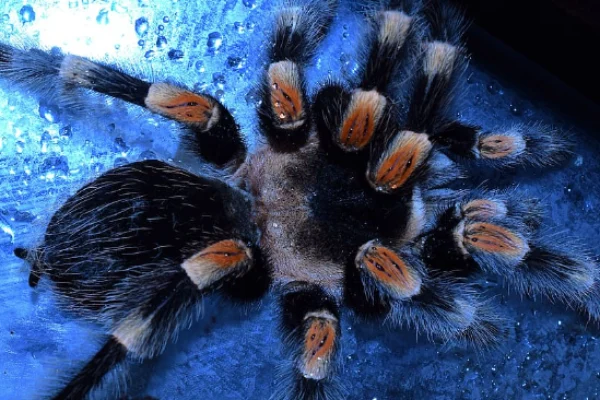
| Scientific name | Brachypelma emilia |
| Size | 5 to 6 inches |
| Diet | Crickets, roaches, locusts, and other insects |
| Geographical location | Western Mexico |
The Mexican red-leg tarantula, scientifically known as Brachypelma emilia, is a remarkable spider found in Western Mexico. As their name suggests, they have dark blue bodies with incredible red legs.
These tarantulas are very popular among pet traders due to their pliant nature. These species are very fascinating and large, with an average size of 5 to 6 inches.
27. Common pink toe*

| Scientific name | Avicularia avicularia |
| Size | up to 6 inches |
| Diet | Crickets, wax moths, grasshoppers, cockroaches and small tree frogs |
| Geographical location | Venezuela, Guyana, Suriname, French Guiana, Trinidad and Tobago to Peru, Bolivia, and Brazil |
Avicularia avicularia or Common pink toe is another spider in this list of blue spiders. The Common pink toe has dark blue colored bodies with pink legs. Juvenile forms have a pink body with blue legs and it changes as they grow.
These spiders mostly like to feed on Crickets, wax moths, grasshoppers, Cockroaches, Small tree frogs, and Small lizards. These tarantulae can grow up to 6 inches when they mature.
One can find these amazing spiders in Venezuela, Guyana, Suriname, French Guiana, Trinidad and Tobago, Peru, Bolivia, and Brazil.
28. Blue Fang Skeleton*
| Scientific name | Ephebopus cyanognathus |
| Size | 4 to 5 inches |
| Diet | insects, reptiles, and small rodents |
| Geographical location | French Guiana |
As their name suggests, Blue Fang skeleton tarantula has remarkable blue jaws. These fascinating spiders have brown carapace, and golden stripes are present on their legs, as you can see in the above picture.
They are medium-sized, with lengths of 4 to 5 inches, and are commonly found in French Guiana. These fossorial spiders are venomous and primarily feed on insects, reptiles, and small rodents.
29. Gooty sapphire tarantula*
| Scientific name | Poecilotheria metallica |
| Size | 2.5 to 3 inches |
| Diet | flying insects, and crickets |
| Geographical location | Andra Pradesh India |
The gooty sapphire tarantula, Poecilotheria metallica, is a beautiful spider found in Andhra Pradesh, India. This old-world tarantula has a fractal-like appearance on its abdomen.
They are less chromatic when they are young and change to blue with aging. These arboreal spiders are used to make asymmetrical funnel webs in large tree holes. Life expectancy in females is much higher than in males. Their venom is highly dangerous and can even be fatal to humans.
30. Amazon Blue baboon tarantula*
| Scientific name | Xenesthis intermedia |
| Size | Up to 8 inches |
| Diet | crickets, roaches, worms, mice, etc |
| Geographical location | Venezuela |
This Amazon blue-bloom tarantula is commonly found in Venezuela and inhabits arid and mountain forests. These most colorful tarantulas are very popular among pet traders. They have purple bodies with striking black patterns, and the legs are blue.
These new world tarantulas are using their stinging hairs in order to defend themselves. These burrow-dwelling spiders are large and can grow up to 8 inches.
Conclusion
Here we conclude our article. These spiders are not only known for their striking blue appearance but also play a very important role in the pet trading business.
Some are venomous, whereas others are not. Most of the venom of these spiders is used in the medical industry. I hope you like this post.
Also Read:

Being a zoology student I’m always been fascinated toward animals especially insects. I love to do research and learn about different animals. As a writer I want to share my thoughts about nature through my articles. Apart from this you can find me exploring the new places and voice notes.
